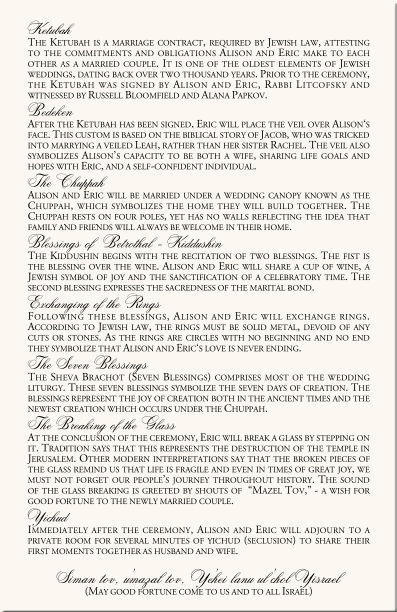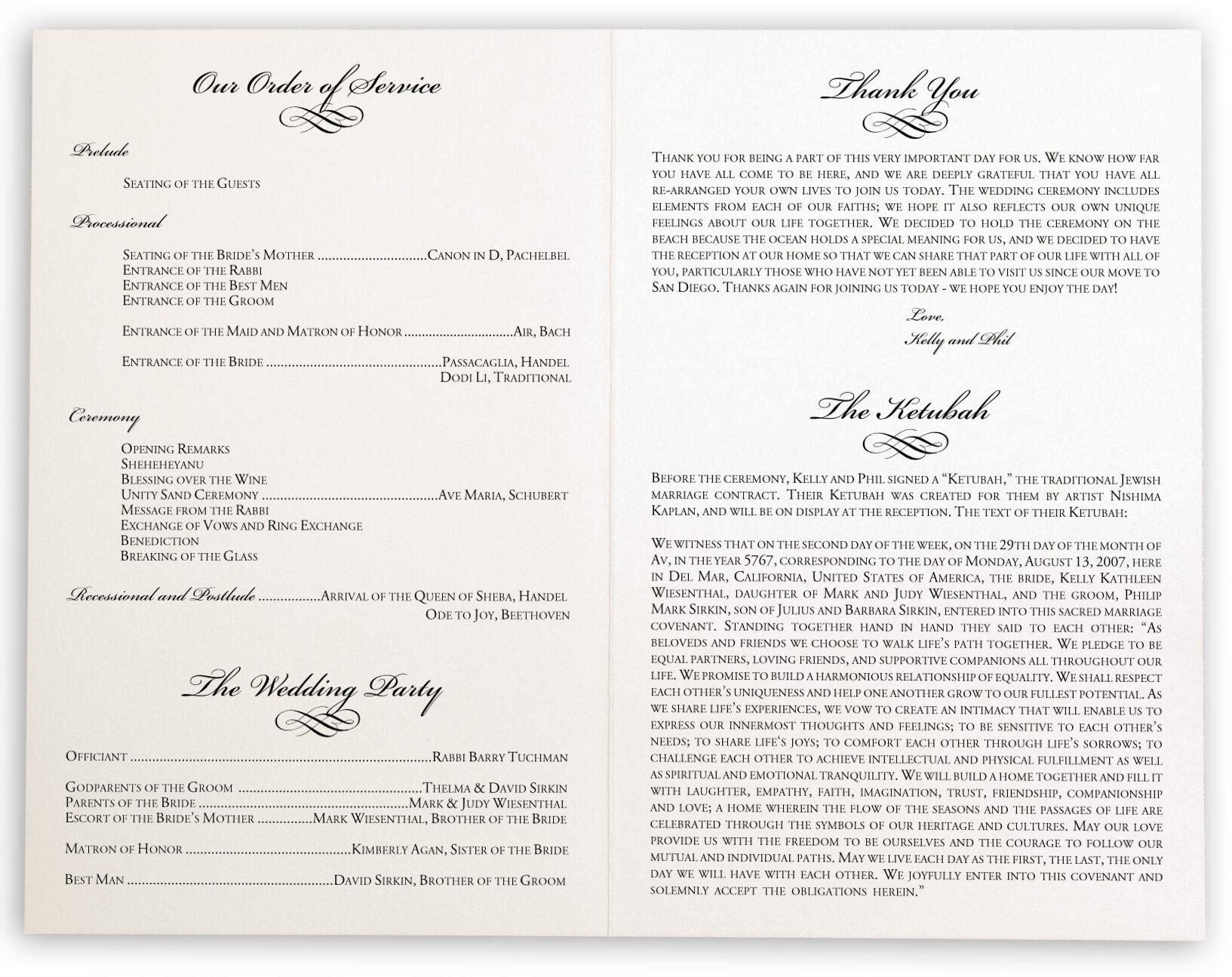Reform Jewish Wedding Ceremony Program
- Reform Jewish Wedding Ceremony Traditions
- Reform Jewish Wedding Ceremony Script
- Jewish Wedding Ceremony
- Jewish Wedding Ceremony Traditions
Sample Traditional Jewish Wedding Program (For an Interfaith community). The wedding ceremony will conclude when Jonathan breaks a glass, a tradition with a myriad of interpretations. Sample Traditional Jewish Wedding Program (For an Interfaith community). The Reform Ceremony The Reform movement was founded in Germany in the second half of the 19th Century. It is rooted in a liberal Jewish tradition within which it's adherents are guided by 'personal choice' rather than 'halacha' (religious law).
Mazel Tov, darlings, you're getting married! You've picked out invitations, auditioned the band, and you're on your way to the perfect wedding. Everything is planned, save for the set of essential details that will turn your big day into a timeless, spiritual event. We're talking minhag, baby: the Jewish wedding customs that create a meaningful link between past, present, and future. Witcher 2 enhanced edition pc.
The Tish
A traditional Jewish wedding begins with a groom's tish, Yiddish for table. The groom attempts to present a lecture on the week's Torah portion, while his male friends and family heckle and interrupt him. Meanwhile, the bride is entertained in another room by her female friends and family. Bride and groom may lead the tish together in Conservative and Reform congregations.
The Ketubah Signing
In Orthodox communities, after the tish the ketubah (Jewish marriage contract) is signed by the groom, the rabbi, and two male witnesses. In Reform and Conservative congregations, the bride may also sign the ketubah, and additonal lines can be added for female witnesses, too. Despite its testimony that the groom has 'acquired' the bride, the ketubah is all about the bride's rights and her willingness to take part in the marriage. In fact, the ketubah belongs solely to the bride and is hers to keep as proof of her rights and the groom's responsibilities to her under Jewish law.
The B'deken
Reform Jewish Wedding Ceremony Traditions
The first time a bride and groom see each other in an Orthodox wedding is during the b'deken, or veiling of the bride. Both fathers and all the men lead the groom to the bride's room, where both mothers and all the women surround her. The groom lowers the veil over her face, setting her apart from everyone else and indicating that he is solely interested in her inner beauty. The ceremony is based on the biblical story in which Jacob did not see his bride's face beforehand and was tricked into marrying the wrong sister, Leah. Some couples have created a more egalitarian veiling ceremony in which the bride places a yarmulke on the groom as he covers her with the veil.
The Huppah
The huppah, or wedding canopy, dates back to the tent-dwelling Jewish nomadic days in the desert. Historically, Jewish wedding ceremonies were held outdoors, and the huppah created an intimate, sanctified space. The canopy offers one of the best opportunities to personalize your ceremony. Since there are no formal requirements for its size, shape, or appearance, you can make your own huppah.
Circling
When the couple first enters the huppah, the bride circles the groom seven times, representing the seven wedding blessings and seven days of creation, and demonstrating that the groom is the center of her world. To make the ancient ritual reciprocal, many couples opt to circle each other.
Kiddushin
The kiddushin (betrothal ceremony) takes place under the huppah. It begins with greetings, a blessing over the wine, and a sip taken by the bride and groom. Next come the rings: The groom recites an ancient Aramaic phrase as he places the wedding band on his bride's right index finger -- the finger believed to be directly connected to the heart. In a double-ring ceremony (not permitted in some Orthodox weddings) the bride also places a ring on the grooms index finger while repeating a feminine form of the Aramaic phrase, or a biblical verse from Hosea or Song of Songs. The ketubah is then read aloud in English and Aramaic.
Sheva B'rachot
The sheva b'rachot, or seven blessings, consist of praise for God, a prayer for peace in Jerusalem, and good wishes for the couple. In Sephardic weddings, before the sheva b'rachot are recited, the parents wrap the couple in a tallis, literally binding them together. The rabbi doesn't have to say all seven blessings. You can honor special guests by asking them to read -- or even sing -- some of the blessings.
Breaking of the Glass

Reform Jewish Wedding Ceremony Script

Jewish Wedding Ceremony
Nothing says 'Jewish wedding' more than the sound of breaking glass. But what's the point? Depending on whom you ask, the breaking of the wineglass is, among other things: a symbol of the destruction of the Temple in Jerusalem; a representation of the fragility of human relationships; and a reminder that marriage changes the lives of individuals forever. It's also the official signal to shout, 'Mazel Tov!' and start partying. There's no law putting the man's foot to the task. If you're game, bride and groom can break the glass together with one swift kick in unison.
The Yihud
Jewish Wedding Ceremony Traditions
In a day filled with chaos, the yihud -- or 'seclusion' -- is a standout ritual that lets you focus on the days true purpose: your new partnership. Immediately after the ceremony, bride and groom retreat to a private room for 15 minutes of personal time. No in-laws, no seating arrangement charts, no videographer. Just you and your new spouse staring into each other's eyes. In days of old, bride and groom would retreat to a nearby tent for a little undercover nookie action. This isn't done much these days, but its customary for newlyweds to seize the yihud moment and feed each other a bite or two of their first meal together.